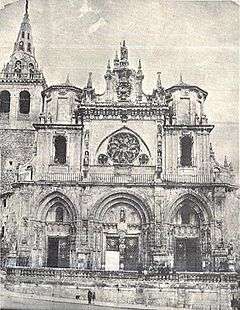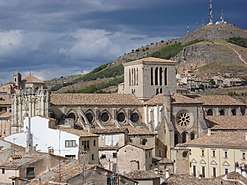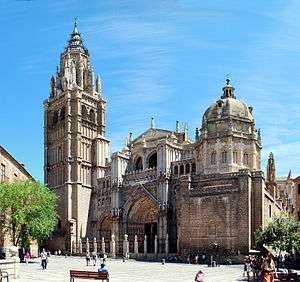Cuenca Cathedral
| Cuenca Cathedral Catedral de Santa María y San Julián de Cuenca | |
|---|---|
 Façade of the cathedral | |
| Basic information | |
| Location | Cuenca, Spain |
| Affiliation | Roman Catholic Church |
| Architectural description | |
| Architectural type | Church |
| Architectural style | Norman architecture, Gothic, Romanesque, NeoGothic |
Cuenca Cathedral is a Gothic church in the city of Cuenca in Cuenca Province in the Castile-La Mancha region of south-eastern central Spain. The building is one of the earliest Spanish examples of Gothic architecture, specifically the Anglo-Norman and French-Norman architecture of the 12th century, as represented by examples such as Soissons Cathedral, Laon Cathedral and Notre Dame de Paris. It was the earlier Romanesque style that dominated the Iberian peninsula around the time the cathedral was constructed.
Work began in the year 1196 and was largely completed in 1257, although further renovations continued. In the 15th century, the Gothic head was reconstructed, while the exterior of the cathedral was almost completely renovated in the 16th century. In the 17th century, the chapel of the Sagrario was built and the façade and the towers were reformed in the Baroque style. In the 18th century the new high altar was built, and at the beginning of the 20th century, due to the collapse of 1902, the façade was reconstructed in an unfinished Neo-Gothic style.
The cathedral is dedicated to Mary and Saint Julián, the second bishop of the Diocese of Cuenca and the patron saint of the city.[1] It is the seat of the Roman Catholic Diocese of Cuenca.
History

On September 21, 1177, Alfonso VIII of Castile "The Noble" conquered the city of Cuenca, defeating the Moors after a nine month siege. The city was constituted as bishopric in 1183, and work commenced on building the cathedral using the foundations of the main Muslim mosque .
The King Don Alfonso, made and ordered that the mosque that the Moors had, commanded the bishops who consecrate themselves ... and put his hand by the Virgin Mary that even if it had, and passed and moved the bishoprics of Valeria and Arcas and put the chair in the his city of Cuenca.
The wife of King Alfonso VIII, Eleanor Plantagenet of England (daughter of Henry II of England and Eleanor of Aquitaine) inspired this cathedral. As part of her dowry, Eleanor Plantagenet was accompanied by a cortege of Norman knights. This arrival of the Norman court influenced the construction of this cathedral - one of the earliest Gothic cathedrals of Castile, together with that of Avila.
The cathedral was consecrated in the early phases of its construction by Saint Julian of Cuenca, second bishop of Cuenca. French stonemasons began work between 1182 and 1189, with work continuing in the 13th century. It was finally consecrated under the invocation of Saint Mary in 1208 by Bishop Rodrigo Ximénez de Rada.
Due to a lightning strike on the cathedral, the Tower of the Giraldo (seen to the left of the facade in early photographs) collapsed on April 13, 1902, also destroying much of the facade. Several children were killed.[2] An initial restoration of its facade was made in a neo-gothic style but is still unfinished. There are plans to restore the destroyed sections.[3]
Characteristics of the Cathedral
As the construction of the cathedral began in the late Romanesque period, there are evident Romanesque traces in the parts of the cathedral. Following common Romanesque style, there were initially five staggered apses, a single transept and three naves in the main body. The initial plan of the cathedral was made up of three naves.

The works were developed in the 13th century when the clerestory was built, with moulded windows and decorated with statues of angels and an oculus. The vaults are sexpartite ribbed.

In the 15th century, the eastern end was rebuilt to create a double ambulatory. In the 17th century the chapter of the cathedral the architect Ventura Rodríguez to raise a Transparent (stained glass that illuminates and decorates the background of an altar) that rival with those by Narciso Tomé in the Cathedral of Toledo.[4] A new altar was built in the eighteenth century, with altarpiece statues by Pasquale Bocciardo. The collapse of Giraldo Tower in 1902 led to widespread damage in the cathedral. This was partially restored by Vicente Lampérez. There are further plans to restore larger destroyed sections of the Cathedral. The latest interventions to date have been the complete restoration of the cloister of the 16th century.
Iconography
According to scholar and architect Rodrigo de Luz, the Holy Grail was saved and preserved here. Subsequently, Cuenca Cathedral, in the final revelation, will not be destroyed, along with all those who take refuge within it. From readings of the Book of Revelations and the Centuries of Nostradamus, the researcher concluded that the two texts refer to the temple where they will receive their salvation.[5]
Stressing the similarities of Cuenca and the New Jerusalem of the books of Revelation, the New Jerusalem will have a pass of salvation, "with 12 gates; in the 12 doors, 12 angels".
The Cathedral of Cuenca fits in this comparison. There are 12 gates in shape of bows, each of which has 12 angels, just as indicated in the book of Revelation. The 12 stone angels were sculpted with sombre faces and each holding a book, except for one, who is smiling happily and holding in her hands a Cup. This has been interpreted showing part of the legend of the Holy Grail, hidden and the Mystery of the Cathedral of Cuenca, where some speculate secretly hides the Holy Grail. [6]

There are more hidden messages in the Cathedral and City of Cuenca, such as the mystery of the shield of arms with shows a cup featuring an 8 pointed star, symbol of the Templars.[7][8]
Development of the Cathedral coinciding with the European Discovery of America in 1492, it boasts sculpted native animals of the newly discovered lands, allowing the Cuencan iconography to stand out from other cathedrals.

Hence the iconography within the Cathedral of Cuenca is largely fantastical, with mythological and human figures interspersed amongst plant leaves, stems, fruits and meandering streams. However, what really sets it apart from the rest are the animals unknown to the West, such as the armadillo, puffer fish or turtle, that appear in its Gothic arches of the late 15th century.[9]
Gallery

 Facade of the Cathedral of Cuenca before 1902
Facade of the Cathedral of Cuenca before 1902
| Wikimedia Commons has media related to Cathedral of Cuenca. |
References
- ↑ "Audio Guia - Catedral de Cuenca". www.catedralcuenca.es. Retrieved 2018-08-08.
- ↑ Rodríguez González, José María (April 13, 2016). "La torre del Giraldo. crónica de un suceso". vocesdecuenca.es tu peródico digital.
- ↑ Cañete, Luis (March 15, 2015). "El exalcalde Andrés Moya solicita la reconstrucción del Giraldo de la Catedral". vocesdecuenca.es tu periódico digital.
- ↑ "La luz y el misterio de las catedrales - Catedral de Cuenca (Santa María y San Julián)". rtve.es. August 1, 2015.
- ↑ De Luz Lamarca, Rodrigo (2009). El misterio de la Catedral de Cuenca. Editortial Alfonsípolis. ISBN 9788495963444.
- ↑ De Luz Lamarca, Rodrigo (2009). El misterio de la Catedral de Cuenca. Editortial Alfonsípolis. ISBN 9788495963444.
- ↑ De Luz Lamarca, Rodrigo (2009). El misterio de la Catedral de Cuenca. Editortial Alfonsípolis. ISBN 9788495963444.
- ↑ "La extraña leyenda de la Catedral de Cuenca". Mundo Oculto. October 30, 2016.
- ↑ José María Rodríguez González (2012). Animal Iconography in the Middle Ages. A singular and unique world in the arcades of Cuenca Cathedral: Journal of Feelsynapsis.JoF. ISSN 2254-3651. Number 4. Pages 40-50.
Bibliography
- "Cathedral of Cuenca". www.arteguias.com/ (in Spanish). 2004. Retrieved February 5, 2007.
- "Cathedral of Cuenca". www.arsvirtual.com/ (in Spanish). 2006. Archived from the original on March 24, 2006. Retrieved February 5, 2007.
- "The Cathedral of Cuenca". www.uv.es/ (in Spanish). Retrieved February 5, 2007.
